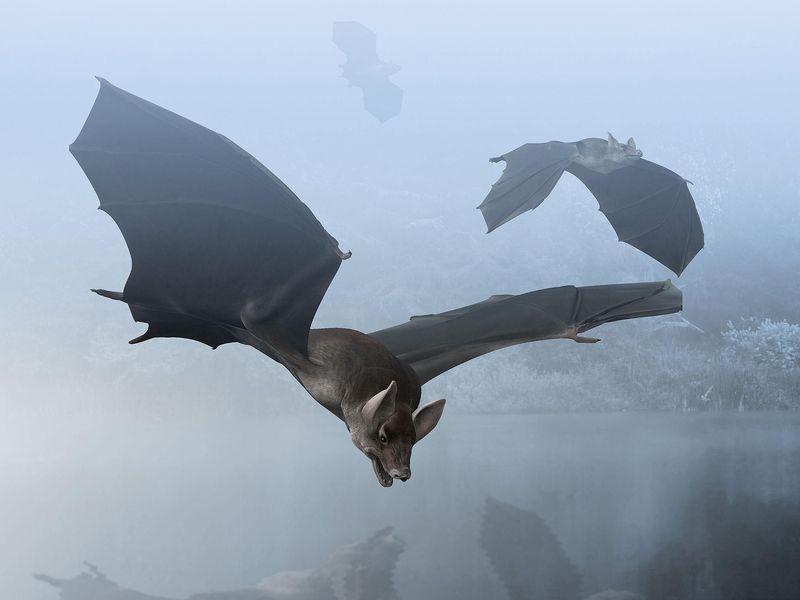Where Did Bats Come From? |Science | Smithsonian Magazine
By: Riley Black (Smithsonian Magazine)



Listen carefully on a quiet summer night and you might hear them. Even if you don’t see a bat’s frantically fluttering form, you might catch its high-pitched chirp as it searches the night for dinner. You’re probably hearing a little brown bat, a common insect-eater found throughout North America, but it is just one of more than a thousand species of bat ranging from the one-inch-long Kitti’s hog-nosed bat to the enormous, three-pound giant golden-crowned flying fox.
Large or small, bats suffer a reputation problem. Aside from being associated with vampires, they’re often called “flying rats” and blamed for the spread of zoonotic diseases into humans (including COVID-19, though whether that blame is founded is as of yet unclear.) This fear often overshadows the fascinating fact that bats are the only mammals to have evolved powered flight, and they’ve been flapping around for tens of millions of years. Where, then, did these flying oddities come from?
Bats pop up in the fossil record around 50 million years ago during a time known as the Eocene. Paleontologists have recovered remains ranging from teeth and bits of jaw to stunning full skeletons in places as far-flung as Wyoming, Paris, Australia and India’s Vastan Mine.

There are some differences between the oldest bats and their modern relatives. Based upon the ear anatomy of the better-preserved specimens, for example, scientists know that the first bats couldn’t echolocate. They relied on sight, smell and touch to find their meals. While modern bats have a claw only on the equivalent of our thumb, earlier bats kept some of the additional finger claws inherited from their ancestors. A fossil bat dating to about 52 million years ago, dubbed Onychonycteris finneryi in 2008, had claws on all five of its fingers. New technology has added a few details to the early bat story, too. A recent study of coloration in the fossil record found that two 48 million-year-old bats found in Germany were mostly brown.
Despite these strides, scientists are left with some big questions. For one thing: The 50-million-year-old bat specimens are already recognizable as bats, so where did they come from? When, where, why and how the first bats become airborne is another mystery buried by Deep Time.
Paleontologists are familiar with such conundrums. For decades, anatomists and zoologists were confounded by the origin of whales. Then, at the end of the 20th century, a wealth of fossil finds provided a detailed outline of how hoofed land mammals became the sea’s largest swimmers. Birds presented a similar problem, with their origin from an unknown reptile ancestor stumping experts until some new ideas about the “terrible lizards” and amazing fossil finds proved that birds are living dinosaurs . Until recently, turtles presented an odd case similar to that of bats; the shelled reptiles seemed to appear out of nowhere in the fossil record. During the past two decades, experts have identified new species of transitional turtles and revised their opinions of already-known species to explain how turtles got their shells .
 Article is LOCKED by moderator [smarty_function_ntUser_get_name: user_id or profile_id parameter required]
Article is LOCKED by moderator [smarty_function_ntUser_get_name: user_id or profile_id parameter required]
Tags
Who is online
54 visitors


Also an interesting read, less creepy than bats, the flying mammals.
creepy is the right word...
Bats are your best friend during skeeter season. They can eat up to 20 times their weight (? I could Wiki that) in skeeters.
They come out at dawn and dusk and I love to watch then swoop and swirl
Isn't it curious that the older species, whales, dolphins, many fish and bats use echolocation to "see" or find hidden food?
How long do you suppose it will be before people develop that one?
I use my olfactory nerves to find food, does that count?
lol
Humans don't really need echolocation to find a food source since we have developed farming and don't have to rely on hunting. I'm trying to think of one good reason humans would need to develop echolocation. We would benefit more from telepathy
Ahhh, the Superstore theory...Target, Sam's et al
Bingo!
Can remember when I was doing Natural Resources at Patrick AFB and we implemented the Bat House plan. Put up 120 bat houses in early spring and by mid-summer you could tell that the skeeter population had really gone down. Luv'd walking the bay at dusk and dawn and watching the bats literally swarming to get the skeeters and other critters.
We even used the guano on our flower gardens throughout the base. Fantastic results.
I've been wanting to put up a bat house. Glad that the guano came in handy